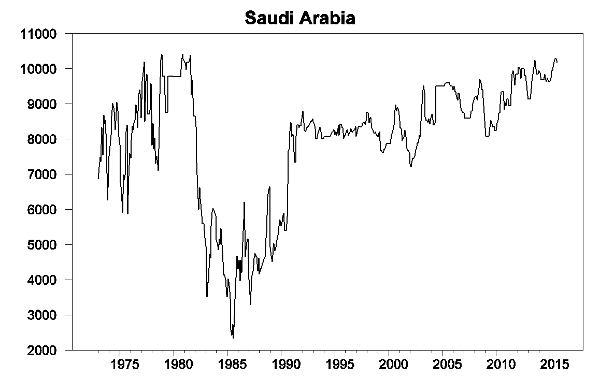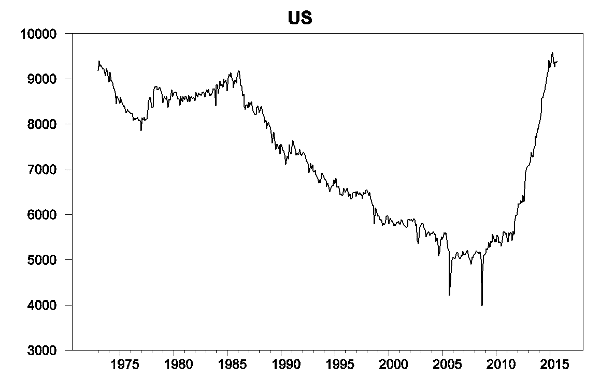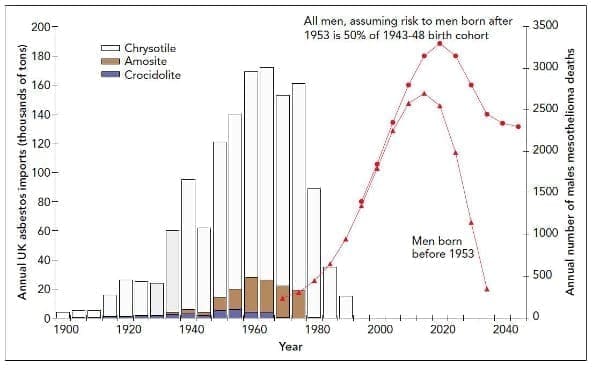Saudi Arabia slashed oil production in the mid-1980s as prices plunged. Not so Today:

Given Saudi Arabia’s long-standing commitment to act as swing producer to stabilize prices, current Saudi behavior raises big questions. Why is Saudi Arabia pumping at historic rates in the face of a collapse in the oil price? And, as President Obama’s state of the union message highlights, what should be the U.S. policy response?
Let’s take it as given that the Saudis remember how to cut production by two-thirds as they did when oil prices fell by about two-thirds in the early 1980s. This time they have increased production in the face of a similar fall. Indeed, the Saudi’s are now pumping more oil than they did in 2008 when the oil price was well over $100 per barrel. What’s so different today?
Perhaps we should start with what’s been the same since the 1970s. Oil prices periodically jump and lead experts to earnestly predict painful (for consumers) rises for oil prices as far as the eye can see. The inevitability of high future prices would justify a dominant producer squeezing production when the oil price sags. But those earnest predictions have repeatedly proven hysterically wrong as supply-side and demand-side considerations kept the real price of oil constant or falling.
What if the Saudi’s have finally gotten the joke? What if they’ve decided that it’s a sucker’s bet to leave that oil in the ground in the hopes that this time the experts are right about an inevitable rapid rise in oil prices? What if their recent actions reveal a commitment to sell now either by pumping or unloading a large share of Aramco?[1] Not only might this be the best long-run strategy, you can throw in some short-term geopolitical advantages as icing on the cake.
Only Yesterday?
Remember crude oil frantically changing hands at $145/bbl? Was that really only seven and half years ago? How did petroleum prices soar through $100/bbl in the middle of the last decade? Estimates of the long term demand for transportation fuel leapt as China and India joined the 21st century. Drilling costs for new fields involved ever more treacherous endeavors. Super-deep water drilling off Angola and dangerous efforts in the Arctic and Antarctica were the only sizable new fields in town. And triple-digit $/bbl price tags were attached to such endeavors.
Electric cars, in turn, were judged to be little more than a novelty. Batteries were heavy, fire prone, and electric cars were expensive to fuel and saddled with painfully limited driving ranges. Refueling took hours, not minutes. Even super-green citizens were ambivalent. Electricity production, the ultimate power source, still likely relied upon some form of fossil fuel.
All of these factors led many experts to predict rising real oil prices on average well into the future. One could imagine Saudi strategists buying this line. You know, just like many experts embraced the frantic Limits to Growth arguments in the 1970s.
Everyone, including Saudi strategists, surely had in mind the framework imagined by William Nordhaus and highlighted by Robert Solow’s 1974 AEA address:
Suppose that, somewhere in the background, there is a technology capable of producing or substituting for a mineral resource at relatively high cost, but on an effectively inexhaustible resource base. Nordhaus calls this a “backstop” technology.”(…The sun will not last forever, but it will last at least as long as we do, more or less by definition) Since there is no scarcity rent to grow exponentially, the backstop technology can operate as soon as the market price rises enough to cover its extraction costs (including, of course, profit on the capital equipment involved in production). And as soon as that happens, the market price of the ore or its substitute stops rising. The “backstop technology” provides a ceiling for the market price of the natural resource.
Solar power, circa 2007, remained the backstop. But its price still remained sky high, relative to 2007 oil prices. In addition, the supply schedule for non-Saudi oil production was steeply upward sloped. The Saudis in that world sell all of their 265 billion barrels of oil in sixty years, all the while watching the real price it collects climb at a pace a good deal faster than one expects to receive in a corporate bond.
Times Change
China and the other emerging market economies will surely be burning a lot of oil. And the recent growing pains don’t warrant a major recalibration of the longer-term growth in global energy demand for transportation and other uses.
But the news on the backstop technology has been nothing short of astounding. Fracking technology has delivered the world a wild increase in oil reserves, relative to 2007 notions, at prices no higher than $75/bbl—prices that are likely to fall with further innovation (Fig. 2).

Thus, even if the Saudi’s slashed production, as in 1980s, to jack up oil prices, the price would likely be capped by a huge increase in fracked oil.
Supposing that Saudi production ran at two-thirds of its current rate for 30 years, it would have sold only about one third of its reserves by the year 2045.[2] And what price would they be receiving for that oil in 20 to 30 years? That surely depends a lot on other innovations, and, in particular, what happens on the development of batteries and electric cars. And the rate of innovation in that area has been astounding.
Nyqvist and Nilsson’s report that “industry-wide cost estimates declined by approximately 14% annually between 2007 and 2014, from above US$1,000 per kWh to around US$410 per kWh,” and that rapid innovation is likely to continue (Fig. 3). Solar power innovations to charge those batteries are arguably on an even more powerful track.

In short, for the next couple of decades fracking may cap the price of oil, and after that, who knows?
Finally, many consumers and most governments seem to believe in science. Those who do are increasingly willing to count environmental costs as part of the cost of using oil, driving the effective price of oil up relative to cleaner alternatives and pulling forward the date at which alternatives really take hold.
You might be skeptical of whether environmental considerations could really lead to a sharp change in consumption patterns. But Saudi strategists might be considering many examples such as that provided by asbestos. As Gee and Greenberg argue, asbestos went from magic to malevolent, and use went from massive to nothing in 10 to 15 years (Fig. 4). (Gee and Greenberg’s main point might bear remembering as well: the signs were clear much earlier, and the price paid for ignoring them came much later than when use was curtailed.)

In the immediate future, the Saudis also confront first-order geo-political issues. Iran and Russia confront them with both money and guns as they fight for influence in the Middle-East. Low oil prices are wreaking havoc in Russia and will limit Iran’s post-sanction ability to rebuild.
Thus, short-run, medium-run, and longer-run consideration may all be arguing for a more aggressive pump and sell strategy. If, on the other hand, the Saudi’s sharply curtail production, as they did in the mid-1980s, they could well lift oil prices substantially. Clearly, however, this would reinvigorate fracking in the USA and over time induce fracking around the world. It would also provide support for Iran’s post-sanction efforts to rebuild its economy and likely accelerate Iran’s détente with the West. An extended period of suppressed Saudi production means non-Saudi oil production would be in position to play an important role in supplying the world with fuel for the next several decades. If solar/battery technological breakthroughs continue apace, the switch to electric vehicles could take hold earlier, and those oil reserves might look like those asbestos reserves, coal reserves, and, for that matter, empty tobacco barns dotting the southern landscape.
And the U.S. Response to a Saudi Strategic Shift?
How might an enlightened U.S. government respond to the Saudi strategy? While climate change, the scientists tell us, is for real, U.S. military strategists tell us that the Iran/Saudi Cold War has never been hotter. Thus, a major Middle East war crippling the world economy will remain a genuine risk. Amid $30/bbl, the U.S. fracking industry is in a state of near complete collapse.
An ideal strategy would thwart Saudi efforts that postpone the move to cleaner energy and electric cars. It would ramp up our insurance policy against a war-induced oil shortage. And as a bonus, it might cushion the blow for the fracking industry.
Imagine the following. The Federal tax on U.S. gasoline is increased by $1.00/gallon. If crude oil prices are in a range between $30/bbl and $50/bbl gas prices would oscillate within a range at the low end of the spread experienced between 2011 and 2015. Fracking company oil wells, now being sold at fire sale prices, are purchased by the Federal government with the wells deemed additions to the strategic petroleum reserve. Only a small portion of the proceeds from the gasoline tax would be required to purchase the fracked wells. The remainder could be used to reduce taxes, so as to make the two changes revenue neutral.[3]
Obviously putting gasoline prices back at $3.00/gallon bolsters the economic motivation to drive hybrid/electric cars. The Federal purchasing of fracked wells does not put the U.S. in the fracking business, unless a Mid-East crisis threatens the U.S. and the world with a destabilizing spike in petroleum prices. In effect, the U.S. government can buy insurance against a Mid-East conflagration on the cheap.
And what is the state of the current political debate? The Obama Administration took a baby step in the right direction by proposing a $10/bbl tax on crude oil with the proceeds used to support both the research and provision of alternative forms of transportation. Anything looking like a tax increase is certainly dead on arrival on Capitol Hill. The Congressional leadership has other fish to fry. The collapse for oil prices may have rendered oil produced from tar sands spectacularly uneconomic. No matter. A full 270 members of the House of Representatives and 62 Senators continue to champion Keystone Pipeline. Perhaps it is a sign of the times that Donald Trump has Keystone misgivings, correctly labelling oil from tar sands dirty. (He adds that he is suspicious of the Keystone Pipeline “because like Cruz it travels from Canada to Texas.”) In short, I’m not counting on a clear-thinking response to the windfall drop in oil prices.
You may be shocked to learn that the Saudis do not share their strategic plans with me. But it is at least worth considering that they have decided that a rising market price of oil is a sucker’s bet. U.S. policymakers should be considering the same possibility.
Notes:
1. With uncharacteristic exuberberance, The Economist argues that this would be the sale of the century and mark the end of the post-War oil order. [back]
2. Based upon EIA estimates of 265 billion barrels of Saudi oil reserves. [back]
3. Rendering the pump price increase tax receipt neutral strips the act of any tilt toward bigger government. Its virtue is that it taxes an activity we want to discourage (fossil fuel use) rather than taxes an activity we want to encourage (earning a living). [back]